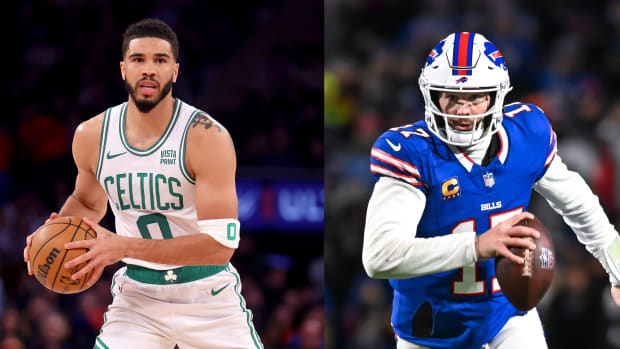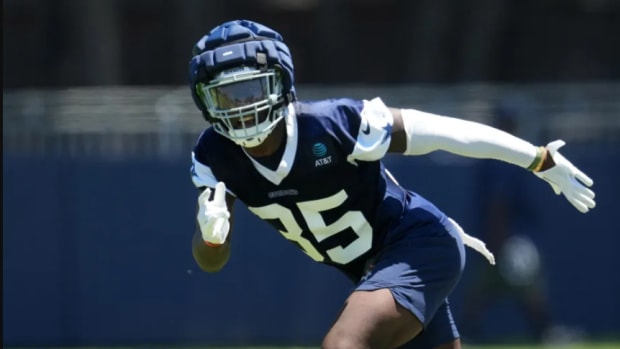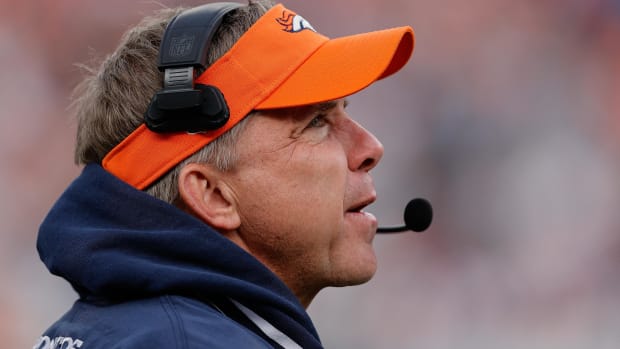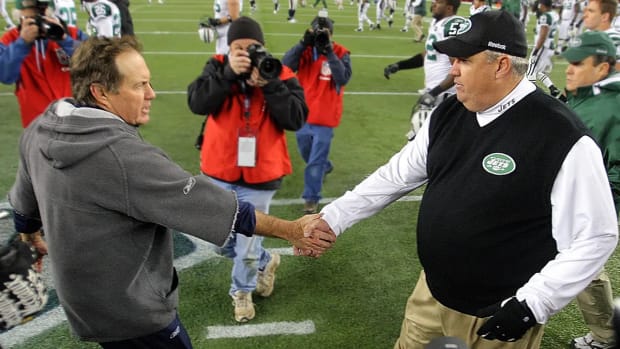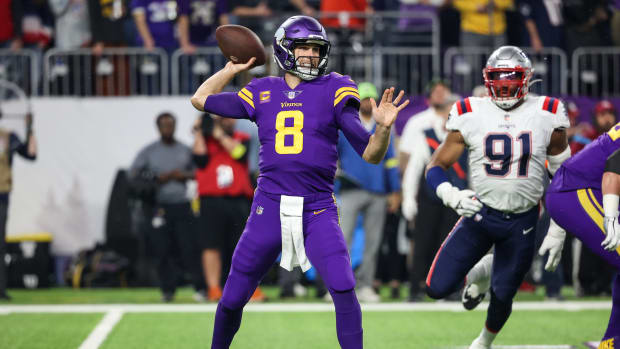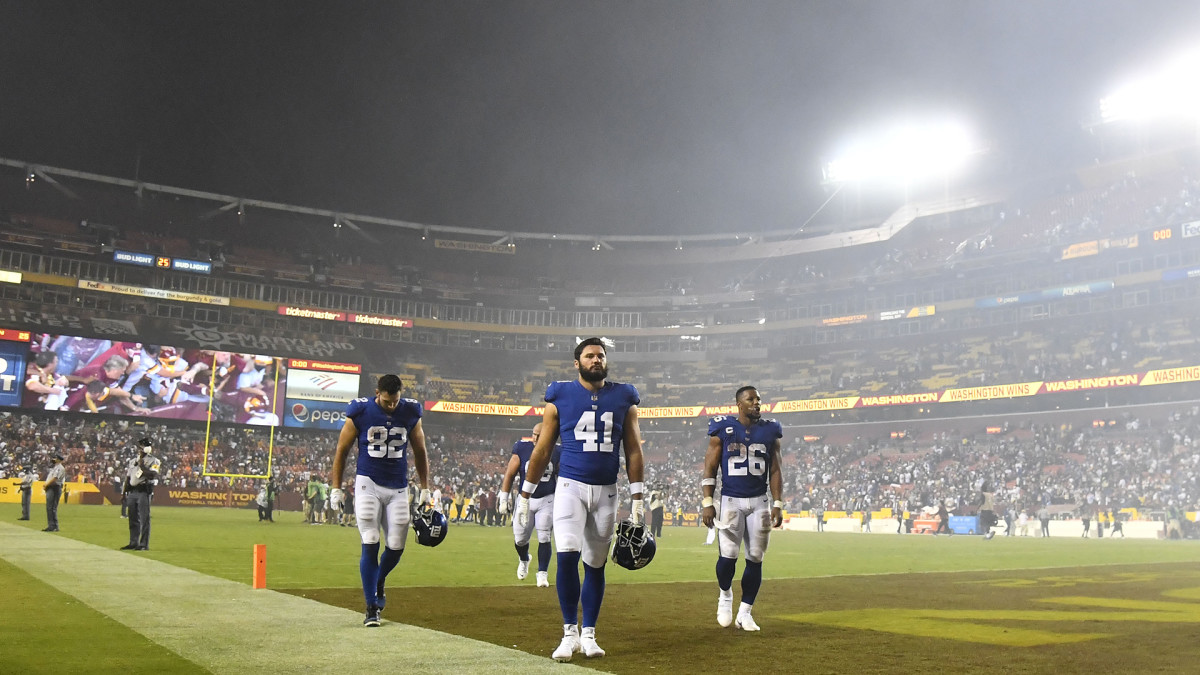
The 17th Game, for the First Time
Were this any other regular season, JC Tretter would be getting ready to head home now. He would be packing up his locker, attending his exit interviews, taking stock with fellow Browns of their 7–9 finish, last in the AFC North. Instead the center is on the phone between team meetings on a Tuesday evening, explaining how he feels as he and the team prepare for an unprecedented—and meaningless, in Cleveland—17th game.
“It’s almost like a body-clock thing,” Tretter says. “You get used to the season being done at 16, because that’s how you’ve always trained. So it’s definitely different.”
Here Tretter is speaking not only as a sturdy nine-year NFL veteran, but from the unique perspective of his other job as NFLPA’s president. His election came in March 2020, amid a world preparing to shut down due to the COVID-19 pandemic and a divided union member base preparing to cast ballots for a new CBA that boiled down to a single issue from which league owners refused to budge. “When you look at the negotiation that was the entire discussion: The NFL’s buying a 17th game, and these are the things we’re getting in return,” Tretter says.
When the new schedule was formally approved by owners and announced in March 2021, reaction ranged from genuine concerns over player safety to dismissive shrugs at the inevitability of the NFL milking this obvious cash cow for its next TV rightsholders deal. For his part, Roger Goodell framed it last September as a “flight to quality” thanks to a slimmed preseason (four games to three), promising that longer regular seasons would “bring even more drama, more opportunities for teams to make it to the postseason and improve the quality of what we do.”
Now that the 17th game is nigh, though, a look at reality reveals underwhelming results. Out of 14 spots in the similarly expanded playoff format that debuted in 2020, just three wild cards will be up for grabs this weekend. A handful of players are within striking distance of new single-season marks—namely Tom Brady (completions), Cooper Kupp (receptions and receiving yards) and T.J. Watt (sacks)—but not even these would-be record-setters seem especially jazzed about the prospect given the automatic asterisk that would taint the accomplishment. “It wouldn’t hold the same weight to me as it does for guys that have done that in a 16-game season,” Kupp told reporters.
Add in the historic havoc wreaked by the tandem blitz of a global pandemic and football’s usual physical toll—61 different quarterbacks had started at least one game through Week 17, most since 2010, according to Stathead; a month earlier the AFC-leading Titans set a record for most players used in a season (86)—and it is enough to raise some big questions about what the NFL’s new normal means for its future.
“There’s a lot of implications,” says Jodi Balsam, a Brooklyn Law School professor who worked in NFL legal affairs from 1994 to 2007. “Are there significant health and safety impacts that can be measured? Is this just a cash grab at the sacrifice of player well-being? And is there a fan appetite? What happens to the product if you have empty stadiums for regular-season games in January?”
The NFL owners emerged from the Arizona Biltmore hotel in Phoenix, weary after an annual spring meeting that stretched on for seven-and-a-half hours. Those March 1977 negotiations were heated, mostly thanks to an Al Davis-led push for more balanced scheduling protocol, and the eventual measure only passed by the slimmest possible voting margin. Even so commissioner Pete Rozelle could hardly hide his glee at the outcome, relaying the inspiration with a wry smile to reporters.
“Money,” Rozelle said, “and not just television money, was the determining factor in adding two more games to the schedule and two more teams to the playoffs.”
Until that point the NFL had only formally expanded its schedule once before: in 1961, from 12 to 14 games, as a thinly veiled countersalvo to the threat posed by the emerging American Football League. “The most ambitious schedule in the history of the circuit,” the Detroit Free Press declared. But it also lacked collectively bargained input, which the league used to its full advantage. “It seems here players … are being given the small end of the horn in being asked to play 14 games at the same salary they were given for 12,” a Los Angeles Mirror columnist wrote that December. “Rozelle, who works for the 14 owners and apparently never heard of overtime, does not agree.”
Not that the NFLPA lodged many objections the second time around in ’77, focusing instead on injury pay, pension benefits and free agency expansion as core tenets of a contract that ended three years of labor strife since the ’74 player strike. Preseason games were trimmed from six to four, an expiring TV rights deal promised tens of millions of dollars more in shared revenue, and everyone seemed happy enough save for football writers wringing their hands over record book sanctity.
“Do we throw it out? Light out charcoal with it? With 16 games won’t it become the NFL asterisk book? Maybe they’ll make the cover an asterisk wearing a football uniform,” one syndicated columnist lamented.
“The 1978 National Football League season may feature more broken records than a music shop in an earthquake zone,” complained another.
The issue of schedule expansion lay mostly dormant for the next four-plus decades, simmering but ultimately fizzling with each subsequent round of CBA talks as players deemed it a non-starter issue. Then, in early 2019 the NFLPA and NFL entered preliminary negotiations for a new contract, three years before the then-current version's 2022 expiration. With revenues booming and a new TV deal on the horizon, owners flexed their leverage with an initial soft offer of an 18-game schedule—a lofty goal that the league had also pursued to no avail in the wake of the 2011 players’ lockout—before taking a hard line of a one-game increase. “It was a condition of getting an early deal done,” Tretter says. “They wanted to go to 17, and it was the NFLPA’s job to get as much out of that as possible.”
For owners and the league, the costs were clearly worth the additional financial benefit: Only one team, reportedly the Bears, cast a dissenting “no” vote when owners agreed last July to start the 17-game season in 2021, the soonest possible date in a three-year window allowed by the CBA. (Chairman George H. McCaskey declined to comment to SI through a team spokesperson.)
Whether the union succeeded in its mission, however, remains a matter of intense debate. Tretter points to the “ton of really great things” that players received in exchange for upping their regular-season workload, including higher minimum salaries, additional time off and greater revenue share of a whopping new TV deal slated to net the league $113 billion over the next 11 years. “Obviously it was a very tight vote, but a majority of our members said yes,” says Tretter, referring to the 1,019-959 margin by which the contract was ratified last March. “I’m sure people who voted no, they won’t just change their minds a year out.”
Criticism, meanwhile, flooded from some of the most famous corners of the union. “A terrible decision,” Tom Brady said. “S--- dumb... as hell,” tweeted Alvin Kamara. Some lashed out at the nearly 500 dues-paying members who failed to cast ballots. Others took aim at NFLPA executive director DeMaurice Smith and union leadership for accepting the league’s 17-game framework as nonnegotiable, rather than rallying for the sort of collective action (messaging campaigns, work stoppages) often required by labor movements to achieve better concessions. “I think we’re always going to have lively discussions, and I think that’s good,” Tretter says. “Guys should voice their opinions. That’s a good thing.” Still more focused on the player-safety implications. “They’re really just saying 17 so that they can get to 18,” NFLPA executive committee member Richard Sherman said during Super Bowl week. “And so that’s two more opportunities for players to risk their bodies, to put their bodies on the line.”
But even players who supported the contract were forced to reckon with some version of this difficult calculus. “There’s definitely a risk of playing an extra game,” Tretter says. “Every time you step on the football field, there’s an inherent risk of injury.” They just reached a different conclusion. “I look at it now, it’s just another week of work, it’s another game,” Tretter says. “I’m not worried about my body not holding up, because we played more games last year [18, including two in the playoffs] than I played this year.”
As the 2021 season moves on, James Andrews has seen the growing signs of a workforce wearing down. His phone is buzzing with sidelined players seeking the famed sports orthopedist’s consultation, including multiple calls on this late-December morning alone. His calendar is filling up with surgery dates: “I’m waiting to do three ACLs right now,” he says. And each Monday it feels like he wakes up to more emails “than ever” from agents attaching MRIs of the ruptured Achilles tendons, popped hamstrings and dislocated shoulders that their clients suffered the previous Sunday.
“It worries me,” Andrews says. “Let’s put it that way.”
On one hand, this trend is nothing new: Andrews says he notices similar “big spikes” in major injuries every winter as football’s punishing physicality cashes out on players’ bodies. “Fatigue is a big factor,” he says. “It’s like an automobile tire. If you put 100,000 miles a year on it, it doesn’t last very long, does it?” On the other, it’s coming at a time when the effects of playing more football are better known than ever yet the NFL is also playing more games than ever. “I think it’s going to take its toll,” Andrews says. “You may not see it initially. But adding extra games, prolonging the actual season, it’s got to be an increased problem.”
The volume of MRIs that arrive in his inbox Monday, in the wake of Week 18, will serve as one small measure. But Andrews notes that comparing year-to-year numbers is relatively unhelpful thanks to the litany of contributing factors. (For the record, through Week 17 and due largely to COVID-19, players had collectively missed 787 more games than at the end of last season, according to Man Games Lost.) “It’s hard to document that,” he says “You’d have to do a long-term study over five or 10 years.”
The NFLPA has taken steps in bargaining to lessen this cumulative impact, citing collectively shared player safety data in lobbying for limited mandatory training camp time and padded practices, in addition to their ongoing recommendation that players skip voluntary offseason activities. “It’s not just how many games did you play,” Tretter says. “It’s how much wear and tear is put on your body for the entire year, from the beginning to the end of the football calendar.” Besides, he adds, the 17-game season seems to have fizzled as the hot topic du jour among players: "More people are complaining about the Thursday night games than about 17 games.”
As history has shown, though, the NFL won’t be inclined to stop here. The current CBA locks the league into 17 games for the next decade despite its best efforts: One early proposal reportedly contained an option allowing owners to move to 18 before the deal expires in 2031. But there is nothing in labor law stopping the owners from renegotiating sooner with further pot-sweeteners to secure what everyone assumes they’ve always wanted all along.
If so, Andrews wonders whether the NFLPA would counter-propose adding a second bye week to help mitigate the fatigue effect; he recommends a league-wide, two-week midseason hiatus. “So they can get the life back in their legs, he says. “I hate to see these high-level players getting hurt at the end of the season like this.” Balsam, the law professor and former NFL counsel, questions whether fans—and even broadcast rightsholders—would have an appetite for a further diluted product . “I’m a Giants season-ticket holder, so I have lots of reasons to not be using my tickets these days,” he says. “But even in a good year, would I go to a January 15 regular-season game?”
For his part, Tretter says he wouldn’t be surprised if the NFL makes a play for an 18-game season next decade. Asked why, he offers a knowing chuckle reminiscent of Rozelle’s wry smile. “Money,” he says. “That’s probably the answer. More games means more products to sell. I’m sure that’d be what would make them want to do it, in the same aspect of what made them want to do it this time around.”
• NFL's Most Fascinating Offense Is in Philadelphia
• Reassessing Mac Jones After His Rookie Season
• Madden’s Revolutionary Impact, Style Will Never Be Replicated
• Previewing the Head Coach Hiring Cycle
































